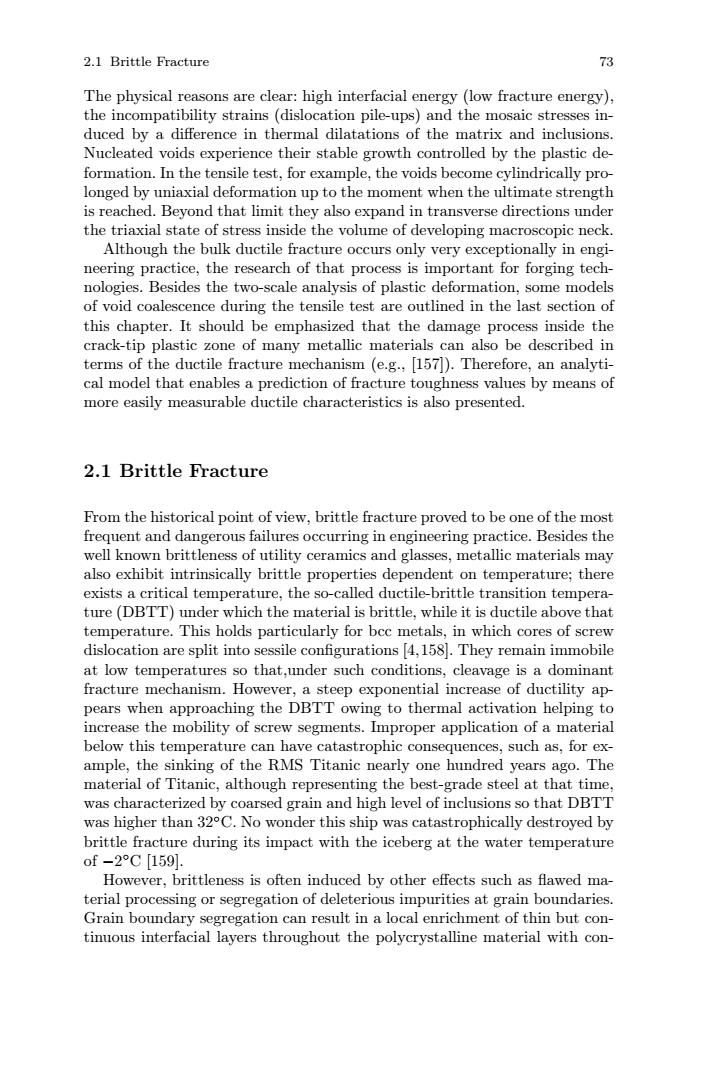正在加载图片...

2.1 Brittle Fracture 73 The physical reasons are clear:high interfacial energy (low fracture energy), the incompatibility strains(dislocation pile-ups)and the mosaic stresses in- duced by a difference in thermal dilatations of the matrix and inclusions. Nucleated voids experience their stable growth controlled by the plastic de- formation.In the tensile test,for example,the voids become cylindrically pro- longed by uniaxial deformation up to the moment when the ultimate strength is reached.Beyond that limit they also expand in transverse directions under the triaxial state of stress inside the volume of developing macroscopic neck. Although the bulk ductile fracture occurs only very exceptionally in engi- neering practice,the research of that process is important for forging tech- nologies.Besides the two-scale analysis of plastic deformation,some models of void coalescence during the tensile test are outlined in the last section of this chapter.It should be emphasized that the damage process inside the crack-tip plastic zone of many metallic materials can also be described in terms of the ductile fracture mechanism (e.g.,[157).Therefore,an analyti- cal model that enables a prediction of fracture toughness values by means of more easily measurable ductile characteristics is also presented. 2.1 Brittle Fracture From the historical point of view,brittle fracture proved to be one of the most frequent and dangerous failures occurring in engineering practice.Besides the well known brittleness of utility ceramics and glasses,metallic materials may also exhibit intrinsically brittle properties dependent on temperature;there exists a critical temperature,the so-called ductile-brittle transition tempera- ture(DBTT)under which the material is brittle,while it is ductile above that temperature.This holds particularly for bcc metals,in which cores of screw dislocation are split into sessile configurations [4,158.They remain immobile at low temperatures so that,under such conditions,cleavage is a dominant fracture mechanism.However,a steep exponential increase of ductility ap- pears when approaching the DBTT owing to thermal activation helping to increase the mobility of screw segments.Improper application of a material below this temperature can have catastrophic consequences,such as,for ex- ample,the sinking of the RMS Titanic nearly one hundred years ago.The material of Titanic,although representing the best-grade steel at that time, was characterized by coarsed grain and high level of inclusions so that DBTT was higher than 32C.No wonder this ship was catastrophically destroyed by brittle fracture during its impact with the iceberg at the water temperature of-2°C[159]. However,brittleness is often induced by other effects such as flawed ma- terial processing or segregation of deleterious impurities at grain boundaries. Grain boundary segregation can result in a local enrichment of thin but con- tinuous interfacial layers throughout the polycrystalline material with con-2.1 Brittle Fracture 73 The physical reasons are clear: high interfacial energy (low fracture energy), the incompatibility strains (dislocation pile-ups) and the mosaic stresses induced by a difference in thermal dilatations of the matrix and inclusions. Nucleated voids experience their stable growth controlled by the plastic deformation. In the tensile test, for example, the voids become cylindrically prolonged by uniaxial deformation up to the moment when the ultimate strength is reached. Beyond that limit they also expand in transverse directions under the triaxial state of stress inside the volume of developing macroscopic neck. Although the bulk ductile fracture occurs only very exceptionally in engineering practice, the research of that process is important for forging technologies. Besides the two-scale analysis of plastic deformation, some models of void coalescence during the tensile test are outlined in the last section of this chapter. It should be emphasized that the damage process inside the crack-tip plastic zone of many metallic materials can also be described in terms of the ductile fracture mechanism (e.g., [157]). Therefore, an analytical model that enables a prediction of fracture toughness values by means of more easily measurable ductile characteristics is also presented. 2.1 Brittle Fracture From the historical point of view, brittle fracture proved to be one of the most frequent and dangerous failures occurring in engineering practice. Besides the well known brittleness of utility ceramics and glasses, metallic materials may also exhibit intrinsically brittle properties dependent on temperature; there exists a critical temperature, the so-called ductile-brittle transition temperature (DBTT) under which the material is brittle, while it is ductile above that temperature. This holds particularly for bcc metals, in which cores of screw dislocation are split into sessile configurations [4,158]. They remain immobile at low temperatures so that,under such conditions, cleavage is a dominant fracture mechanism. However, a steep exponential increase of ductility appears when approaching the DBTT owing to thermal activation helping to increase the mobility of screw segments. Improper application of a material below this temperature can have catastrophic consequences, such as, for example, the sinking of the RMS Titanic nearly one hundred years ago. The material of Titanic, although representing the best-grade steel at that time, was characterized by coarsed grain and high level of inclusions so that DBTT was higher than 32◦C. No wonder this ship was catastrophically destroyed by brittle fracture during its impact with the iceberg at the water temperature of −2◦C [159]. However, brittleness is often induced by other effects such as flawed material processing or segregation of deleterious impurities at grain boundaries. Grain boundary segregation can result in a local enrichment of thin but continuous interfacial layers throughout the polycrystalline material with con-